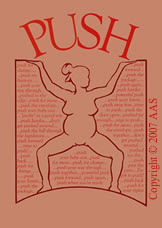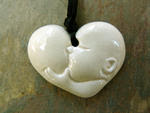by L. Janel Martin-Miranda
I've mentioned my bias about Hummers -- related to my son's deployment to Iraq. I have learned from other family members of deployed that Hummers are sort of a universal representation of and epitomize what this war is about on one level ... a society that is fearful, consumerism driven, self-centered, power hungry, and careless. And, we family members see Hummers as totally irreverant to our soldier's sacrifice, many of whom are dying in Hummers. For oil. Oil for Hummer drivers in particular. When I think of the consequence of liability avoidance, control, the cost in dollars and lives, and the harm to babies and mamas, Obstetrics is sort of right up there with Hummers, to me -- so out of proportion, gawdy, flashy, slick, irreverant, careless of others, fearful, and greedy. A sick blend of luxury and fear that leads to "too much." Meanwhile, a solid, dependable, good-lookin' Toyota -- like midwifery -- is sensible, safe, conservative, efficient, comfortable, and gets one there without all the ego, fear, and cost to the family and to society.
Last week I watched The Girl in the Cafe about four times . [About a shy civil servant (Bill Nighy, Love Actually) working for the British delegation to the 2005 Millineum Goals Summit to promote implementing plans to lower maternal and child mortality due to extreme poverty. She's an alluring young woman (Kelly McDonald, Finding Neverland) he meets at a cafe - and invites her to the Summit on a whim. Together, this unlikely couple might just change history.]And, this week I've been reading an interesting Save the Children document.
http://www.savethechildren.org/publications/mothers
/2006/SOWM_2006_final.pdf
Some alarming statistics from both have me awake wondering ..... every three seconds a child dies of extreme poverty. Every year 4 million babies die in the first month of life.
Four million babies are born in the United States every year and nearly 20,000 will die within their first month of life. Ten thousand more will die before their first birthday. BUT, did you know that four million is ALSO the very same number of babies who die within the first month of life around the world? And, ONLY 20,000 of the 4 million are in the US. Most of the four million babies are of color and born in third world countries where Tetanus, infections, diarrhea cause 36% of the deaths. Poor care during childbirth is also a factor -- most women have no access to any prenatal or medical care, but midwifery care is not given as reason for the neonatal rates. Midwives deliver babies out of hospitals because there are no doctors or hospitals, but the reasons for high death rates according to Save the Children are not because of midwives or even lack of doctors. It is generational poverty, disease, and malnourishment.
Meanwhile, ugly debating in this country about the relatively insignificant numbers of neonatal deaths in the US between home and hospital birth make me feel as ashamed this week -- as if I were to stuff myself at a huge smorgasbord while listening to my friend's slide show of her trip to Africa, and God-forbid, drive home in a Hummer.
According to Save the Children, three of the 4 million babies will die within the first week and 1/2 of those are within the first 24 hours. Prematurity complications account for 27% and asphyxia accounts for only 23%. Prenatal nutrition and lifestyle that is attributed to fewer problems in US births is a major problem around the world in third world countries. Sixty to 80% of babies weigh less than 5#. In India the death rate of poor babies is fifty-six percent higher than the rich. In Bolivia, Niger, Peru and Viet Nam the death rate of babies born in rural areas is fifty percent higher than those born in urban areas.
According to the document, 3 million of the four million neonatal deaths could be stopped by simply addressing the disease and health conditions - as have the industrialized nations. Makes me think of recent claims I have read about how obstetric medicine is responsible for the decreased neonatal mortality rates in the US, when we all know that it is antibiotics, good nutrition, clean water, and health care that addresses tetanus, infections, and diarrhea -- the real reasons for the difference in mortality rates from 100 years ago. It is not induction, narcotics, interventions, high tech gadgets (monitoring), and cesarean surgery that is saving lives. These are "bells and whistles" on the monster of a machine used unnecessarily on the majority of birthing women in the US. The Hummer of birth -- when truly, like in Europe and Japan, a Toyota does the job wihout so much consequence. Industrialized countries in Europe with low maternal and neonatal mortality rates (and small economical vehicles) have a woman-centered midwifery model of care and midwives function in partnership with physicians.
And, the disparity between rich and poor and white and non-white, and rural versus urban exist in every state in the US. What is all of this arrogance and disregard about (safety of birth in the US) when non-white women and babies are four times more likely to die than white women -- in the US in the twenty-first century? The claim about obstetrics as the savior of the women (world) doesn't hold up. Proportionately, the number of neonatal and maternal rates of women of color in the US are as alarming as in third world countries. Where is the compassion and alarm of the greatest country on the planet -- for their own babies and those of the world?? Last week I featured a story by a second year resident -- he worked in a city hospital where 95% of the women and babies were non-white and on medicaid. Yeah, a teaching hospital where doctors learn on women and babies. Who in obstetrics has the balls to gather data on the disparity between white and non-white, rich and poor, and rural and urban in the US and to look at the lack of a standard of care in obstetrics that includes midwifery? And, who will develop and implement an action plan? - - rather than focus on the 1% of women who want to birth at home and ensuring the increasing surgical rates?
Midwives and homebirth are not the problem in these third world countries, as the Save the Children project points out. The report also shows that midwives (not medwives) are the predominant caregivers in countries with low neonatal and maternal death rates. Addressing disease, health, and sanitation would cut the death rate from four million to one million -- very similar to the decline here in the US. The US lags behind European and other industrialized nations in making birth safe for women and babies.
In the US in the state of Missouri a midwife practicing as CNM, DEM, or CPM can find herself with a felony charge of practicing medicine without a license. As is the case in most rural areas, quality care -- neither obstetric or midwifery is available. Missouri women from rural areas often must travel hours to birth in the larger towns and cities -- this means higher inductions and planned csections, AND, there is an increasing prematurity rate, mortality rate, AND an ever increasing meth-amphetamine problem as the rates of children being born "under the influence" of narcotics also increases ... hmm, at the same rate as epidural's lifecycle to becoming "natural" and "normal". A reasonable, simple, doable solution exists for Missouri and every other US state and third world countries --- implement what has worked in the UK, Sweden, Denmark, and Netherlands since the thirties. And, that is, midwifery care for low risk women, decrease the environmental health concerns, and develop professional partnerships between midwives and doctors -- AND, develop a national standard of care with overseeing and accountibility from outside the medical, obstetric community. Stop letting the fox guard the chickens (and stop the drug dealers from feeding the foxes).
It's pretty clear what can be done in third world countries to save millions of lives every year -- and thousands of lives of non-white women and babies in the US. What if we were able to provide the necessary tools and supplies to support third world countries to overcome the disease and poor water and nutrition conditions and lower the neonatal death from to one million babies world wide (from 4 million) and support midwifery care, like is being done successfully in Afghanistan to lower it even more?
That leads me to another question -- What would happen to all of these babies who survived birth? Is there a natural process (of the fittest) going on or is there a racist process going on? Around the world, and in the US?
to be continued ...
The Other Side of the Glass
Part One was officially released June 2013 in digital distribution format.
To purchase to to www.theothersideoftheglass.com
If you were a donor and want to download your copy send an email to theothersideoftheglassfilm@gmail.com.
The trailer
Subscribe to:
Post Comments (Atom)
"Soft is the heart of a child. Do not harden it."
A public awareness reminder that things that happen behind the scenes, out of our sight, aren't always as rosy as we might think them to be. Perhaps its a restaurant cook who accidentally drops your burger
on the floor before placing it on the bun and serving it to you. Here it's an overworked apathetic (pathetic) nurse giving my newborn daughter her first bath.
Please comment and rate this video, so as to insure that it is viewed as widely as possible, perhaps to prevent other such abuse. -- The mother who posted this YouTube. How NOT to wash a baby on YouTube
Are you going to try to tell me that "babies don't remember?" There is no difference to this baby's experience and the imprinting of her nervous system/brain and one that is held and cleaned by the mother or father either at the hospital or at home?
By the way, this is probably NOT the baby's first bath. The nurse is ungloved. Medical staff protocol is that they can't handle a baby ungloved until is has been bathed (scrubbed if you've seen it) because the baby is a BIO-HAZARD -- for them. Never mind that the bio-hazard IS the baby's first line of defense against hospital germs.
Missouri Senator Louden Speaks
Finally, A Birth Film for Fathers
Part One of the "The Other Side of the Glass: Finally, A Birth Film for and about Men" was released June, 2013.
Through presentation of the current research and stories of fathers, the routine use of interventions are questioned. How we protect and support the physiological need of the human newborn attachment sequence is the foundation for creating safe birth wherever birth happens.
Based on knowing that babies are sentient beings and the experience of birth is remembered in the body, mind, and soul, fathers are asked to research for themselves what is best for their partner and baby and to prepare to protect their baby.
The film is designed for midwives, doulas, and couples, particularly fathers to work with their caregivers. Doctors and nurses in the medical environment are asked to "be kind" to the laboring, birthing baby, and newborn. They are called to be accountable for doing what science has been so clear about for decades. The mother-baby relationship is core for life. Doctors and nurses and hospital caregivers and administrators are asked to create protocols that protect the mother-baby relationship.
Men are asked to join together to address the vagaries of the medical system that harm their partner, baby and self in the process of the most defining moments of their lives. Men are asked to begin to challenge the system BEFORE they even conceive babies as there is no way to be assured of being able to protect his loved ones once they are in the medical machine, the war zone, on the conveyor belt -- some of the ways that men describe their journey into fatherhood in the medicine culture.
Donors can email theothersideoftheglassfilm@gmail.com to get a digital copy.
Through presentation of the current research and stories of fathers, the routine use of interventions are questioned. How we protect and support the physiological need of the human newborn attachment sequence is the foundation for creating safe birth wherever birth happens.
Based on knowing that babies are sentient beings and the experience of birth is remembered in the body, mind, and soul, fathers are asked to research for themselves what is best for their partner and baby and to prepare to protect their baby.
The film is designed for midwives, doulas, and couples, particularly fathers to work with their caregivers. Doctors and nurses in the medical environment are asked to "be kind" to the laboring, birthing baby, and newborn. They are called to be accountable for doing what science has been so clear about for decades. The mother-baby relationship is core for life. Doctors and nurses and hospital caregivers and administrators are asked to create protocols that protect the mother-baby relationship.
Men are asked to join together to address the vagaries of the medical system that harm their partner, baby and self in the process of the most defining moments of their lives. Men are asked to begin to challenge the system BEFORE they even conceive babies as there is no way to be assured of being able to protect his loved ones once they are in the medical machine, the war zone, on the conveyor belt -- some of the ways that men describe their journey into fatherhood in the medicine culture.
Donors can email theothersideoftheglassfilm@gmail.com to get a digital copy.
Buy the film at www.theothersideoftheglass.com.
The film focuses on the male baby, his journey from the womb to the world and reveals healing and integrating the mother, father, and baby's wounded birth experience. The film is about the restoring of our families, society, and world through birthing loved, protected, and nurtured males (and females, of course). It's about empowering males to support the females to birth humanity safely, lovingly, and consciously.
Finally, a birth film for fathers.
The film focuses on the male baby, his journey from the womb to the world and reveals healing and integrating the mother, father, and baby's wounded birth experience. The film is about the restoring of our families, society, and world through birthing loved, protected, and nurtured males (and females, of course). It's about empowering males to support the females to birth humanity safely, lovingly, and consciously.
Finally, a birth film for fathers.
What People Are Saying About the FIlm
Well, I finally had a chance to check out the trailer and .. wow! It's nice that they're acknowledging the father has more than just cursory rights (of course mom's rights are rarely acknowledged either) and it's great that they're bringing out the impact of the experience on the newborn, but I'm really impressed that they're not shying away from the political side.
They are rightly calling what happens in every American maternity unit, every day, by its rightful name - abuse. Abuse of the newborn, abuse of the parents and their rights, abuse of the supposedly sacrosanct ethical principal of patient autonomy and the medico-legal doctrine of informed consent, which has been long ago discarded in all but name. I love it!
In the immortal words of the "shrub", "bring it on!" This film needs to be shown and if I can help facilitate or promote it, let me know.
Father in Asheville, NC
Thanks for sharing this. It was very touching to me. I thought of my brother-in-law standing on the other side of the glass when my sister had to have a C-section with her first child because the doctor was missing his golf date. I'll never forget his pacing back and forth and my realizing that he was already a father, even though he hadn't been allowed to be with his son yet.
Margaret, Columbia, MO
They are rightly calling what happens in every American maternity unit, every day, by its rightful name - abuse. Abuse of the newborn, abuse of the parents and their rights, abuse of the supposedly sacrosanct ethical principal of patient autonomy and the medico-legal doctrine of informed consent, which has been long ago discarded in all but name. I love it!
In the immortal words of the "shrub", "bring it on!" This film needs to be shown and if I can help facilitate or promote it, let me know.
Father in Asheville, NC
OMG'ess, I just saw the trailer and am in tears. This is so needed. I watch over and over and over as fathers get swallowed in the fear of hospitals birth practice. I need a tool like this to help fathers see how very vital it is for them to protect their partner and baby. I am torn apart every time I see a father stand back and chew his knuckle while his wife is essentially assaulted or his baby is left to lie there screaming.
Please send me more info!!!!
Carrie Hankins
CD(DONA), CCCE, Aspiring Midwife
720-936-3609
Thanks for sharing this. It was very touching to me. I thought of my brother-in-law standing on the other side of the glass when my sister had to have a C-section with her first child because the doctor was missing his golf date. I'll never forget his pacing back and forth and my realizing that he was already a father, even though he hadn't been allowed to be with his son yet.
Margaret, Columbia, MO
In case you don't find me here
Soon, I'll be back to heavy-duty editing and it will be quiet here again. I keep thinking this blog is winding down, and then it revives. It is so important to me.
I wish I'd kept a blog of my journey with this film this past 10 months. It's been amazing.
I have a new blog address for the film, and will keep a journal of simple reporting of the journey for the rest of the film.
www.theothersideoftheglassthefilm.blogspot.com
I'll be heading east this week to meet with a group of men. I plan to post pictures and clips on the film blog.
I'll keep up here when I can -- when I learn something juicy, outrageous, or inspiring related to making birth safer for the birthing baby.
I wish I'd kept a blog of my journey with this film this past 10 months. It's been amazing.
I have a new blog address for the film, and will keep a journal of simple reporting of the journey for the rest of the film.
www.theothersideoftheglassthefilm.blogspot.com
I'll be heading east this week to meet with a group of men. I plan to post pictures and clips on the film blog.
I'll keep up here when I can -- when I learn something juicy, outrageous, or inspiring related to making birth safer for the birthing baby.
Review of the film
Most of us were born surrounded by people who had no clue about how aware and feeling we were. This trailer triggers a lot of emotions for people if they have not considered the baby's needs and were not considered as a baby. Most of us born in the US were not. The final film will include detailed and profound information about the science-based, cutting-edge therapies for healing birth trauma.
The full film will have the interviews of a wider spectrum of professionals and fathers, and will include a third birth, at home, where the caregivers do a necessary intervention, suctioning, while being conscious of the baby.
The final version will feature OBs, RNs, CNMs, LM, CPM, Doulas, childbirth educators, pre and perinatal psychologists and trauma healing therapists, physiologists, neurologists, speech therapists and lots and lots of fathers -- will hopefully be done in early 2009.
The final version will include the science needed to advocated for delayed cord clamping, and the science that shows when a baby needs to be suctioned and addresses other interventions. Experts in conscious parenting will teach how to be present with a sentient newborn in a conscious, gentle way -- especially when administering life-saving techniques.
The goal is to keep the baby in the mother's arms so that the baby gets all of his or her placental blood and to avoid unnecessary, violating, and abusive touch and interactions. When we do that, whether at home or hospital, with doctor or midwife, the birth is safe for the father. The "trick" for birthing men and women is how to make it happen in the hospital.
The full film will have the interviews of a wider spectrum of professionals and fathers, and will include a third birth, at home, where the caregivers do a necessary intervention, suctioning, while being conscious of the baby.
The final version will feature OBs, RNs, CNMs, LM, CPM, Doulas, childbirth educators, pre and perinatal psychologists and trauma healing therapists, physiologists, neurologists, speech therapists and lots and lots of fathers -- will hopefully be done in early 2009.
The final version will include the science needed to advocated for delayed cord clamping, and the science that shows when a baby needs to be suctioned and addresses other interventions. Experts in conscious parenting will teach how to be present with a sentient newborn in a conscious, gentle way -- especially when administering life-saving techniques.
The goal is to keep the baby in the mother's arms so that the baby gets all of his or her placental blood and to avoid unnecessary, violating, and abusive touch and interactions. When we do that, whether at home or hospital, with doctor or midwife, the birth is safe for the father. The "trick" for birthing men and women is how to make it happen in the hospital.








1 comment:
What's the difference? The iPhone is so pricy, and now the 3g is so much cheaper.
________________
[url=http://unlockiphone22.com]unlock iphone[/url]
Post a Comment